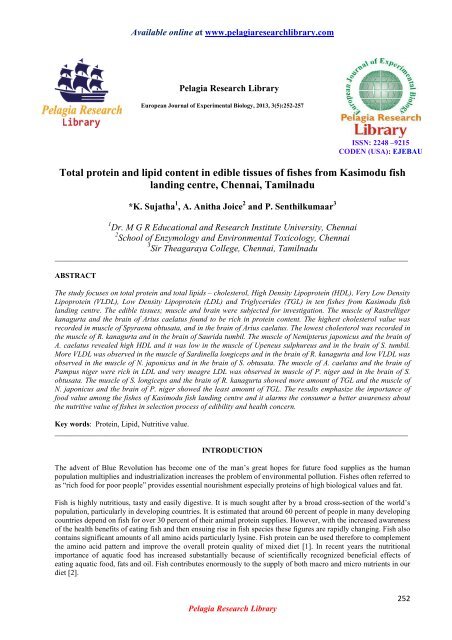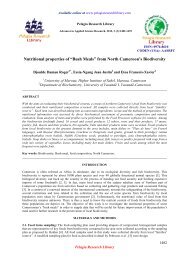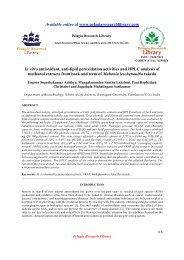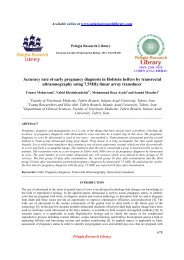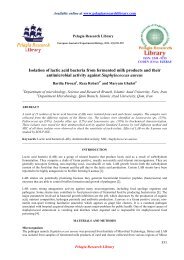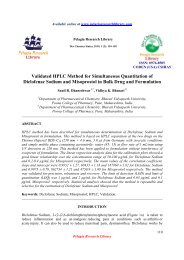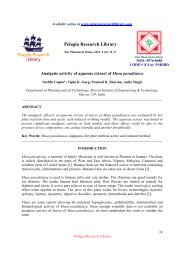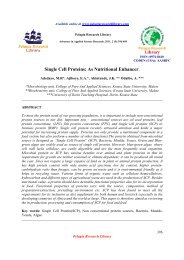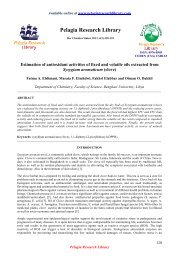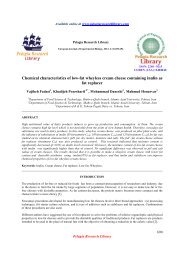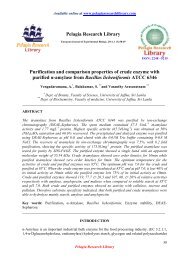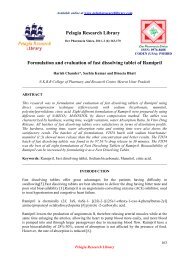Total protein and lipid content in edible tissues of fishes from ...
Total protein and lipid content in edible tissues of fishes from ...
Total protein and lipid content in edible tissues of fishes from ...
You also want an ePaper? Increase the reach of your titles
YUMPU automatically turns print PDFs into web optimized ePapers that Google loves.
Available onl<strong>in</strong>e at www.pelagiaresearchlibrary.com<br />
Pelagia Research Library<br />
European Journal <strong>of</strong> Experimental Biology, 2013, 3(5):252-257<br />
ISSN: 2248 –9215<br />
CODEN (USA): EJEBAU<br />
<strong>Total</strong> <strong>prote<strong>in</strong></strong> <strong>and</strong> <strong>lipid</strong> <strong>content</strong> <strong>in</strong> <strong>edible</strong> <strong>tissues</strong> <strong>of</strong> <strong>fishes</strong> <strong>from</strong> Kasimodu fish<br />
l<strong>and</strong><strong>in</strong>g centre, Chennai, Tamilnadu<br />
*K. Sujatha 1 , A. Anitha Joice 2 <strong>and</strong> P. Senthilkumaar 3<br />
1 Dr. M G R Educational <strong>and</strong> Research Institute University, Chennai<br />
2 School <strong>of</strong> Enzymology <strong>and</strong> Environmental Toxicology, Chennai<br />
3 Sir Theagaraya College, Chennai, Tamilnadu<br />
_____________________________________________________________________________________________<br />
ABSTRACT<br />
The study focuses on total <strong>prote<strong>in</strong></strong> <strong>and</strong> total <strong>lipid</strong>s – cholesterol, High Density Lipo<strong>prote<strong>in</strong></strong> (HDL), Very Low Density<br />
Lipo<strong>prote<strong>in</strong></strong> (VLDL), Low Density Lipo<strong>prote<strong>in</strong></strong> (LDL) <strong>and</strong> Triglycerides (TGL) <strong>in</strong> ten <strong>fishes</strong> <strong>from</strong> Kasimodu fish<br />
l<strong>and</strong><strong>in</strong>g centre. The <strong>edible</strong> <strong>tissues</strong>; muscle <strong>and</strong> bra<strong>in</strong> were subjected for <strong>in</strong>vestigation. The muscle <strong>of</strong> Rastrelliger<br />
kanagurta <strong>and</strong> the bra<strong>in</strong> <strong>of</strong> Arius caelatus found to be rich <strong>in</strong> <strong>prote<strong>in</strong></strong> <strong>content</strong>. The highest cholesterol value was<br />
recorded <strong>in</strong> muscle <strong>of</strong> Spyraena obtusata, <strong>and</strong> <strong>in</strong> the bra<strong>in</strong> <strong>of</strong> Arius caelatus. The lowest cholesterol was recorded <strong>in</strong><br />
the muscle <strong>of</strong> R. kanagurta <strong>and</strong> <strong>in</strong> the bra<strong>in</strong> <strong>of</strong> Saurida tumbil. The muscle <strong>of</strong> Nemipterus japonicus <strong>and</strong> the bra<strong>in</strong> <strong>of</strong><br />
A. caelatus revealed high HDL <strong>and</strong> it was low <strong>in</strong> the muscle <strong>of</strong> Upeneus sulphureus <strong>and</strong> <strong>in</strong> the bra<strong>in</strong> <strong>of</strong> S. tumbil.<br />
More VLDL was observed <strong>in</strong> the muscle <strong>of</strong> Sard<strong>in</strong>ella longiceps <strong>and</strong> <strong>in</strong> the bra<strong>in</strong> <strong>of</strong> R. kanagurta <strong>and</strong> low VLDL was<br />
observed <strong>in</strong> the muscle <strong>of</strong> N. japonicus <strong>and</strong> <strong>in</strong> the bra<strong>in</strong> <strong>of</strong> S. obtusata. The muscle <strong>of</strong> A. caelatus <strong>and</strong> the bra<strong>in</strong> <strong>of</strong><br />
Pampus niger were rich <strong>in</strong> LDL <strong>and</strong> very meagre LDL was observed <strong>in</strong> muscle <strong>of</strong> P. niger <strong>and</strong> <strong>in</strong> the bra<strong>in</strong> <strong>of</strong> S.<br />
obtusata. The muscle <strong>of</strong> S. longiceps <strong>and</strong> the bra<strong>in</strong> <strong>of</strong> R. kanagurta showed more amount <strong>of</strong> TGL <strong>and</strong> the muscle <strong>of</strong><br />
N. japonicus <strong>and</strong> the bra<strong>in</strong> <strong>of</strong> P. niger showed the least amount <strong>of</strong> TGL. The results emphasize the importance <strong>of</strong><br />
food value among the <strong>fishes</strong> <strong>of</strong> Kasimodu fish l<strong>and</strong><strong>in</strong>g centre <strong>and</strong> it alarms the consumer a better awareness about<br />
the nutritive value <strong>of</strong> <strong>fishes</strong> <strong>in</strong> selection process <strong>of</strong> edibility <strong>and</strong> health concern.<br />
Key words: Prote<strong>in</strong>, Lipid, Nutritive value.<br />
_____________________________________________________________________________________________<br />
INTRODUCTION<br />
The advent <strong>of</strong> Blue Revolution has become one <strong>of</strong> the man’s great hopes for future food supplies as the human<br />
population multiplies <strong>and</strong> <strong>in</strong>dustrialization <strong>in</strong>creases the problem <strong>of</strong> environmental pollution. Fishes <strong>of</strong>ten referred to<br />
as “rich food for poor people” provides essential nourishment especially <strong>prote<strong>in</strong></strong>s <strong>of</strong> high biological values <strong>and</strong> fat.<br />
Fish is highly nutritious, tasty <strong>and</strong> easily digestive. It is much sought after by a broad cross-section <strong>of</strong> the world’s<br />
population, particularly <strong>in</strong> develop<strong>in</strong>g countries. It is estimated that around 60 percent <strong>of</strong> people <strong>in</strong> many develop<strong>in</strong>g<br />
countries depend on fish for over 30 percent <strong>of</strong> their animal <strong>prote<strong>in</strong></strong> supplies. However, with the <strong>in</strong>creased awareness<br />
<strong>of</strong> the health benefits <strong>of</strong> eat<strong>in</strong>g fish <strong>and</strong> then ensu<strong>in</strong>g rise <strong>in</strong> fish species these figures are rapidly chang<strong>in</strong>g. Fish also<br />
conta<strong>in</strong>s significant amounts <strong>of</strong> all am<strong>in</strong>o acids particularly lys<strong>in</strong>e. Fish <strong>prote<strong>in</strong></strong> can be used therefore to complement<br />
the am<strong>in</strong>o acid pattern <strong>and</strong> improve the overall <strong>prote<strong>in</strong></strong> quality <strong>of</strong> mixed diet [1]. In recent years the nutritional<br />
importance <strong>of</strong> aquatic food has <strong>in</strong>creased substantially because <strong>of</strong> scientifically recognized beneficial effects <strong>of</strong><br />
eat<strong>in</strong>g aquatic food, fats <strong>and</strong> oil. Fish contributes enormously to the supply <strong>of</strong> both macro <strong>and</strong> micro nutrients <strong>in</strong> our<br />
diet [2].<br />
Pelagia Research Library<br />
252
K. Sujatha et al Euro. J. Exp. Bio., 2013, 3(5):252-257<br />
_____________________________________________________________________________<br />
Malnutrition is a general term that <strong>in</strong>dicates a lack <strong>of</strong> some or all nutritional elements necessary for human health.<br />
Prote<strong>in</strong> Energy Malnutrition- the lack <strong>of</strong> enough <strong>prote<strong>in</strong></strong> <strong>and</strong> food that provides energy which all the basic food<br />
groups provide is the most lethal form <strong>of</strong> malnutrition/ hunger. It is basically a lack <strong>of</strong> calories <strong>and</strong> <strong>prote<strong>in</strong></strong>.<br />
Fish <strong>prote<strong>in</strong></strong> conta<strong>in</strong>s all the essential am<strong>in</strong>o acids <strong>in</strong> required proportions <strong>and</strong> hence has a high nutritional value,<br />
which contribute to their high biological value. Fish is highly <strong>prote<strong>in</strong></strong>ous food consumed by the populace. A larger<br />
percentage <strong>of</strong> consumers do eat fish because <strong>of</strong> its availability, flavor<strong>in</strong>g <strong>and</strong> palatability while fewer do so because<br />
<strong>of</strong> its nutritive valve [3].<br />
Lipids <strong>and</strong> their components play vital role <strong>in</strong> the biochemical adaptations <strong>of</strong> liv<strong>in</strong>g organism that dwell <strong>in</strong> the<br />
severe <strong>and</strong> unique conditions <strong>of</strong> the Northern latitudes. These <strong>lipid</strong>s are <strong>of</strong> major importance <strong>in</strong> the ecological <strong>and</strong><br />
biochemical monitor<strong>in</strong>g <strong>and</strong> test<strong>in</strong>g <strong>of</strong> aquatic organisms. The role <strong>of</strong> <strong>lipid</strong>s <strong>in</strong> cellular metabolism is versatile,<br />
although three ma<strong>in</strong> functions have been <strong>in</strong>dentified: energetic; structural <strong>and</strong> bioeffector roles (i.e. <strong>lipid</strong>s act<strong>in</strong>g as<br />
messengers) [4]. Fish <strong>lipid</strong> conta<strong>in</strong>s long-cha<strong>in</strong> n3 (omega-3) PUFA, particularly EPA <strong>and</strong> DHA. Consumptions <strong>of</strong><br />
these PUFA’s have been perceived to be important <strong>in</strong> human nutrition, health <strong>and</strong> disease prevention. World fish<br />
<strong>lipid</strong> request cont<strong>in</strong>ue to <strong>in</strong>crease. Cholesterol is undoubtedly the most publicized <strong>lipid</strong> <strong>in</strong> nature, because <strong>of</strong> the<br />
strong correlation between high levels <strong>of</strong> cholesterol <strong>in</strong> seasonal differences <strong>and</strong> significant losses may occur dur<strong>in</strong>g<br />
process<strong>in</strong>g <strong>and</strong> storage <strong>of</strong> foods [5].<br />
MATERIALS AND METHODS<br />
Ten <strong>fishes</strong> namely Anchoviella <strong>in</strong>dica, Arius caelatus, Mugil cephalus, Nemipterus japonicus, Pampus niger,<br />
Rastrelliger kanagurta, Sard<strong>in</strong>ella longiceps, Saurida tumbil, Spyraena obtusata <strong>and</strong> Upeneus sulphureus were<br />
selected <strong>from</strong> East Coast <strong>of</strong> Northern Tamilnadu, Kasimodu fish l<strong>and</strong><strong>in</strong>g centre. <strong>Total</strong> Prote<strong>in</strong>, <strong>Total</strong> Lipid – <strong>Total</strong><br />
Cholesterol, High Density Lipo<strong>prote<strong>in</strong></strong> (HDL), Very Low Density Lipo<strong>prote<strong>in</strong></strong> (VLDL), Low Density Lipo<strong>prote<strong>in</strong></strong><br />
(LDL),) <strong>and</strong> Triglycerides (TGL) <strong>content</strong>s were studied.<br />
Bra<strong>in</strong> <strong>and</strong> Muscle were taken <strong>from</strong> all the <strong>fishes</strong> selected <strong>and</strong> approximately 100 mg <strong>of</strong> <strong>tissues</strong> were weighed,<br />
homogenized <strong>in</strong> the sal<strong>in</strong>e medium <strong>and</strong> centrifuged. The supernatant was taken for further studies. The <strong>prote<strong>in</strong></strong><br />
<strong>content</strong> was estimated by the dye b<strong>in</strong>d<strong>in</strong>g method <strong>of</strong> [6], <strong>Total</strong> Cholesterol [7], Estimation <strong>of</strong> Lipo<strong>prote<strong>in</strong></strong>s [8],<br />
Estimation <strong>of</strong> Triglycerides [9], Estimation <strong>of</strong> HDL [10].<br />
RESULTS AND DISCUSSION<br />
<strong>Total</strong> Prote<strong>in</strong> <strong>content</strong> <strong>of</strong> the <strong>fishes</strong> namely A. <strong>in</strong>dica, A. caelatus, M. cephalus, N. japonicus, P. niger, R. kanagurta,<br />
S. longiceps, S. tumbil, S. obtusata <strong>and</strong> U. sulphureus were represented <strong>in</strong> Table:1 <strong>and</strong> Figure: 1. <strong>Total</strong> Cholesterol<br />
<strong>content</strong> <strong>in</strong> muscle <strong>and</strong> bra<strong>in</strong> <strong>of</strong> ten <strong>fishes</strong> were picturized <strong>in</strong> Table: 2. The data <strong>of</strong> High Density Lipo<strong>prote<strong>in</strong></strong> level <strong>in</strong><br />
muscle <strong>and</strong> bra<strong>in</strong> <strong>of</strong> ten <strong>fishes</strong> is furnished <strong>in</strong> Table:3. Very Low Density Lipo<strong>prote<strong>in</strong></strong> values <strong>of</strong> both the <strong>tissues</strong> are<br />
tabulated <strong>in</strong> Table 4 <strong>and</strong> Low Density Lipo<strong>prote<strong>in</strong></strong> values <strong>of</strong> both the <strong>tissues</strong> are tabulated <strong>in</strong> Table 5. Information<br />
about Triglycerides <strong>in</strong> both muscle <strong>and</strong> bra<strong>in</strong> <strong>tissues</strong> <strong>of</strong> ten <strong>fishes</strong> <strong>from</strong> Kasimodu fish l<strong>and</strong><strong>in</strong>g centre is shown <strong>in</strong><br />
Table:6. The variations among the <strong>fishes</strong> with reference to different <strong>lipid</strong> parameters were represented <strong>in</strong> Figure: 2.<br />
Table 1: <strong>Total</strong> <strong>prote<strong>in</strong></strong> <strong>content</strong> (µg/100 mg <strong>of</strong> tissue)<br />
FISHES MUSCLE BRAIN<br />
A. <strong>in</strong>dica 1 118.27±1.40 14.07±3.04<br />
A. caelatus 138.07±1.72 38.60±1.11<br />
M. cephalus 139.47±0.72 20.47±1.30<br />
N. japonicus 142.27±1.72 18.27±1.50<br />
P. niger 116.40±5.10 13.53±0.95<br />
R. kanagurta 180.07±1.89 24.93±1.72<br />
S. longiceps 67.50±1.11 25.93±3.19<br />
S. tumbil 99.47±0.70 24.6±1.94<br />
S. obtusata 113.60±0.80 17.47±0.83<br />
U. sulphureus 157.27±1.47 12.13±1.70<br />
Pelagia Research Library<br />
253
K. Sujatha et al Euro. J. Exp. Bio., 2013, 3(5):252-257<br />
_____________________________________________________________________________<br />
Figure 1: <strong>Total</strong> <strong>prote<strong>in</strong></strong> <strong>content</strong> (µg/100 mg <strong>of</strong> tissue)<br />
200<br />
180<br />
160<br />
140<br />
120<br />
100<br />
80<br />
60<br />
40<br />
20<br />
0<br />
MUSCLE<br />
BRAIN<br />
.<br />
Table 2: <strong>Total</strong> cholesterol <strong>content</strong> (µg/100 mg <strong>of</strong> tissue)<br />
FISHES MUSCLE BRAIN<br />
A. <strong>in</strong>dica 22.26±0.41 41.90±1.47<br />
A. caelatus 26.80±0.72 86.40±1.31<br />
M. cephalus 26.26±0.90 51.03±1.45<br />
N. japonicus 22.86±1.30 53.20±0.80<br />
P. niger 25.65±0.55 69.73±0.70<br />
R. kanagurta 20.16±0.99 72.00±1.70<br />
S. longiceps 27.20±0.87 53.53±1.13<br />
S. tumbil 24.86±0.70 41.20±0.87<br />
S. obtusata 27.20±0.81 54.83±0.77<br />
U. sulphureus 20.53±0.70 41.56±1.76<br />
Table 3: High Density Lipo<strong>prote<strong>in</strong></strong> (µg/100 mg <strong>of</strong> tissue)<br />
FISHES MUSCLE BRAIN<br />
A. <strong>in</strong>dica 12.12±1.37 28.22±1.66<br />
A. caelatus 12.56±1.47 45.24±3.40<br />
M. cephalus 1.73±1.22 29.53±1.07<br />
N. japonicus 15.13±1.11 38.35±1.71<br />
P. niger 13.24±1.24 38.27±1.19<br />
R. kanagurta 11.71±1.86 38.04±1.74<br />
S. longiceps 10.28±1.17 34.47±2.41<br />
S. tumbil 12.37±1.21 2 2.85±1.18<br />
S. obtusata 14.53±0.67 40.66±1.26<br />
U. sulphureus 7.39±1.24 28.20±1.97<br />
Table 4: Very Low Density Lipo<strong>prote<strong>in</strong></strong> (µg/100 mg <strong>of</strong> tissue)<br />
FISHES MUSCLE BRAIN<br />
A. <strong>in</strong>dica 10.43±0.90 11.13±0.27<br />
A. caelatus 8.49±0.71 13.04±0.20<br />
M. cephalus 9.19±0.95 12.01±0.15<br />
N. japonicus 7.12±0.98 11.45±0.85<br />
P. niger 10.11±0.35 11.51±0.63<br />
R. kanagurta 8.05±1.31 16.20±0.49<br />
S. longiceps 12.56±0.93 14.30±0.62<br />
S. tumbil 8.75±0.31 14.62±0.60<br />
S. obtusata 10.23±0.18 1 0.47±1.08<br />
U. sulphureus 7.72±0.62 11.14±1.50<br />
Pelagia Research Library<br />
254
K. Sujatha et al Euro. J. Exp. Bio., 2013, 3(5):252-257<br />
_____________________________________________________________________________<br />
Table 5: Low Density Lipo<strong>prote<strong>in</strong></strong> (µg/100 mg <strong>of</strong> tissue)<br />
FISHES MUSCLE BRAIN<br />
A. <strong>in</strong>dica 0.99±0.34 2.52±0.80<br />
A. caelatus 5.73±0.80 14.49±1.32<br />
M. cephalus 4.29±0.65 7.96±1.85<br />
N. japonicus 1.22±0.37 4.64±0.86<br />
P. niger 0.93±0.41 19.86±1.26<br />
R. kanagurta 0.99±0.24 16.49±1.24<br />
S. longiceps 1.46±0.60 4.45±1.05<br />
S. tumbil 2.38±0.59 1.91±1.03<br />
S. obtusata 1.16±0.23 1.56±0.47<br />
Table 6: Triglycerides (µg/100 mg <strong>of</strong> tissue)<br />
FISHES MUSCLE BRAIN<br />
A. <strong>in</strong>dica 69.29±0.73 54.86±0.30<br />
A. caelatus 63.32±1.13 65.77±0.33<br />
M. cephalus 59.13±1.76 59.63±0.86<br />
N. japonicus 58.22±1.55 59.63±0.86<br />
P. niger 61.10±0.96 50.58±0.68<br />
R. kanagurta 67.33±1.42 79.50±1.57<br />
S. longiceps 98.55±1.59 74.43±0.77<br />
S. tumbil 69.54±1.04 79.36±1.02<br />
S. obtusata 75.11±1.18 53.36±1.32<br />
U. sulphureus 60.47±1.01 59.84±1.16<br />
Figure 2: Variations <strong>in</strong> <strong>lipid</strong> <strong>content</strong> <strong>in</strong> muscle <strong>and</strong> bra<strong>in</strong> <strong>of</strong> ten <strong>fishes</strong> <strong>from</strong> Kasimodu fish l<strong>and</strong><strong>in</strong>g centre (µg/100 mg <strong>of</strong> tissue)<br />
120<br />
100<br />
80<br />
60<br />
40<br />
20<br />
0<br />
Muscle Bra<strong>in</strong> Muscle Bra<strong>in</strong> Muscle Bra<strong>in</strong> Muscle Bra<strong>in</strong> Muscle Bra<strong>in</strong><br />
<strong>Total</strong><br />
Cholestrol<br />
HDL VLDL LDL TGL<br />
A. <strong>in</strong>dica<br />
A. caelatus<br />
M. cephalus<br />
N. japonicas<br />
P. niger<br />
R. kanagurta<br />
S. longiceps<br />
S. tumbil<br />
S. obtusata<br />
U. sulphureus<br />
.<br />
Biochemical studies are very important <strong>from</strong> the nutritional po<strong>in</strong>t <strong>of</strong> view. Prote<strong>in</strong> is essential for the sustenance <strong>of</strong><br />
life <strong>and</strong> accord<strong>in</strong>gly exists <strong>in</strong> the largest quantity <strong>of</strong> all nutrients as a component <strong>of</strong> the human body [11]. In various<br />
fish species, <strong>prote<strong>in</strong></strong>s are <strong>of</strong> important as structural compounds, biocatalysts <strong>and</strong> hormones for control <strong>of</strong> growth <strong>and</strong><br />
differentiations [12]. Prote<strong>in</strong> <strong>in</strong> fish is a ma<strong>in</strong> component constituent <strong>of</strong> tissue <strong>and</strong> organs. They are precursors <strong>of</strong><br />
other nitrogen compounds (enzymes, hormones, slurry, neurotransmitters, c<strong>of</strong>actors, etc) <strong>and</strong> constitute an important<br />
energy source. The effect <strong>of</strong> dietary <strong>lipid</strong> levels on fish growth performance varies considerably with<strong>in</strong> species, size,<br />
age, diet <strong>and</strong> composition, range <strong>of</strong> <strong>lipid</strong>s level tested <strong>and</strong> rear<strong>in</strong>g conditions [13]. Inadequate <strong>prote<strong>in</strong></strong> levels <strong>in</strong> the<br />
diets result <strong>in</strong> a reduction <strong>of</strong> growth <strong>and</strong> loss <strong>of</strong> weight. However, when an excess <strong>of</strong> <strong>prote<strong>in</strong></strong> is supplied <strong>in</strong> the diet,<br />
only part <strong>of</strong> it is used for <strong>prote<strong>in</strong></strong> synthesis (growth) <strong>and</strong> the rema<strong>in</strong><strong>in</strong>g is transformed <strong>in</strong>to energy [14].<br />
Each body cell is composed ma<strong>in</strong>ly <strong>of</strong> <strong>prote<strong>in</strong></strong>. Prote<strong>in</strong> makes up the membrane surround<strong>in</strong>g the cell <strong>and</strong> also occurs<br />
with<strong>in</strong> the cell. Dur<strong>in</strong>g growth period, adolescence <strong>and</strong> pregnancy, the number <strong>of</strong> cell <strong>in</strong>creases <strong>and</strong> more <strong>prote<strong>in</strong></strong> is<br />
required for cell growth. In all stages <strong>of</strong> life tissue <strong>prote<strong>in</strong></strong> is constantly be<strong>in</strong>g broken down <strong>and</strong> must be replaced by<br />
dietary <strong>prote<strong>in</strong></strong>. Prote<strong>in</strong> plays a vital role <strong>in</strong> the formation <strong>of</strong> enzymes, antibodies <strong>and</strong> hormones <strong>and</strong> other substances<br />
that regulate the body process.<br />
Pelagia Research Library<br />
255
K. Sujatha et al Euro. J. Exp. Bio., 2013, 3(5):252-257<br />
_____________________________________________________________________________<br />
Fish <strong>and</strong> shellfish are important source <strong>of</strong> <strong>prote<strong>in</strong></strong> <strong>and</strong> <strong>in</strong>come for people <strong>in</strong> Southeastern Asia [15]. They are also<br />
<strong>in</strong>creas<strong>in</strong>gly marketed for the health benefits to consumers [16]. The requirement <strong>of</strong> nitrogen <strong>and</strong> sulphur is<br />
regulated by dietary <strong>prote<strong>in</strong></strong>. The <strong>prote<strong>in</strong></strong> immunoglob<strong>in</strong>s act as prime defense aga<strong>in</strong>st bacterial <strong>and</strong> viral <strong>in</strong>fections.<br />
Prote<strong>in</strong>s by means <strong>of</strong> exert<strong>in</strong>g osmotic pressure help <strong>in</strong> ma<strong>in</strong>tenance <strong>of</strong> electrolyte <strong>and</strong> water balance <strong>in</strong> human<br />
system. Several studies show that <strong>prote<strong>in</strong></strong> derived <strong>from</strong> fish, balances many body regulatory factors.<br />
It is well known that <strong>prote<strong>in</strong></strong> is the most important <strong>and</strong> expensive item that should be supplied <strong>in</strong> adequate amounts<br />
to support good growth with m<strong>in</strong>imal cost [17], [18]. [19] determ<strong>in</strong>ed the proximate composition <strong>and</strong> energetic<br />
values <strong>of</strong> selected mar<strong>in</strong>e fish <strong>and</strong> shellfish <strong>from</strong> West Coast <strong>of</strong> Penisular Malaysia. This study has <strong>in</strong>cluded 20<br />
species <strong>of</strong> fish 10 pelagic fish <strong>and</strong> 10 demersal fish. The study revealed that Long tail shad (Terunk) conta<strong>in</strong>ed high<br />
fat <strong>content</strong>. Long-tailed butterfly ray conta<strong>in</strong>ed the highest <strong>prote<strong>in</strong></strong>. Similarly <strong>in</strong> our study the fish Rastrelliger<br />
kanagurta is found to be a healthy choice because it conta<strong>in</strong>s highest amount <strong>of</strong> <strong>prote<strong>in</strong></strong> <strong>and</strong> lowest quantity <strong>of</strong><br />
cholesterol. The bra<strong>in</strong> <strong>of</strong> Arius caelatus is found to be effective because it conta<strong>in</strong>s high <strong>prote<strong>in</strong></strong> <strong>content</strong>, high<br />
cholesterol value <strong>and</strong> high HDL. Accord<strong>in</strong>g to the work done by [20] <strong>in</strong> Catfish it is clear that antimicrobial <strong>prote<strong>in</strong></strong>s<br />
<strong>and</strong> peptides play key role <strong>in</strong> <strong>in</strong>nate immunity <strong>and</strong> they had been observed <strong>from</strong> a wide variety <strong>of</strong> organisms <strong>in</strong> last<br />
few years. Hence, the <strong>fishes</strong> rich <strong>in</strong> <strong>prote<strong>in</strong></strong> will produce more <strong>in</strong>nate immunity. R. kanagurta would be more useful<br />
<strong>in</strong> develop<strong>in</strong>g <strong>in</strong>nate immunity.<br />
Cholesterol is undoubtedly the most publicized <strong>lipid</strong> <strong>in</strong> nature, because <strong>of</strong> the strong correlation between high levels<br />
<strong>of</strong> cholesterol <strong>in</strong> the blood <strong>and</strong> the <strong>in</strong>cidence <strong>of</strong> disease <strong>of</strong> the cardiovascular system <strong>in</strong> humans. Usually, the<br />
cholesterol <strong>content</strong> will be more <strong>in</strong> fish liver oils but <strong>in</strong> the present <strong>in</strong>vestigation the consumable part <strong>of</strong> fish, muscle<br />
<strong>and</strong> bra<strong>in</strong> were found to conta<strong>in</strong> cholesterol. It is the essential constituent <strong>of</strong> cells. It aids <strong>in</strong> the permeability <strong>of</strong> the<br />
cells. It controls the red cells <strong>from</strong> be<strong>in</strong>g easily homolyzed. It functions as the defensive action <strong>and</strong> transports fat to<br />
liver <strong>in</strong> the form <strong>of</strong> cholesterol ester for oxidation. It assists the formation <strong>of</strong> bile acids <strong>and</strong> bile salts, 7-<br />
dehydrocholestrol <strong>and</strong> vitam<strong>in</strong> D3, corticosteroid hormone, <strong>and</strong>rogens, estrogens <strong>and</strong> progesterone. Cholesterol<br />
helps the granulation <strong>of</strong> cell division <strong>and</strong> acts as an antagonist to phospho<strong>lipid</strong>s.<br />
High Density Lipo<strong>prote<strong>in</strong></strong> (HDL) transports cholesterol <strong>and</strong> its esters <strong>from</strong> peripheral <strong>tissues</strong> to the liver for its<br />
catabolism (scaveng<strong>in</strong>g action). Very Low Density Lipo<strong>prote<strong>in</strong></strong> (VLDL) transports ma<strong>in</strong>ly endogenous triglycerides<br />
synthesized <strong>in</strong> hepatic cells <strong>from</strong> the liver to the extra-hepatic tissue <strong>in</strong>clud<strong>in</strong>g adipose tissue for storage. Low<br />
Density Lipo<strong>prote<strong>in</strong></strong> (LDL) regulates cholesterol synthesis <strong>in</strong> extra-hepatic tissue. The triglycerides are the most<br />
abundant <strong>of</strong> all <strong>lipid</strong>s. They constitute about 98% <strong>of</strong> total dietary <strong>lipid</strong>s, the rema<strong>in</strong><strong>in</strong>g 2% consists <strong>of</strong> phospho<strong>lipid</strong>s<br />
<strong>and</strong> cholesterol <strong>and</strong> its ester. They are major components <strong>of</strong> storage or depot fats <strong>in</strong> animal cells but not normally<br />
found <strong>in</strong> membranes. Triglycerides can be stored <strong>in</strong> quantities, sufficient to supply the energy needs <strong>of</strong> the body for<br />
many months as <strong>in</strong> the case <strong>of</strong> obese person. They are not only stored for longer duration but also yield over twice as<br />
much energy as carbohydrates.<br />
Lipids <strong>and</strong> fatty acids play a significant role <strong>in</strong> membrane <strong>and</strong> have a direct impact on membrane mediated process<br />
such as osmoregulation, nutrient assimilation <strong>and</strong> transport. On the other h<strong>and</strong>, the nature <strong>and</strong> quantity <strong>of</strong> these<br />
<strong>lipid</strong>s <strong>in</strong> fish vary accord<strong>in</strong>g to species <strong>and</strong> habit [21]. Previous studies correlate with our present <strong>in</strong>vestigation<br />
perta<strong>in</strong><strong>in</strong>g to <strong>lipid</strong> observations.<br />
CONCLUSION<br />
Nutrition is core pillar <strong>of</strong> human development. High prevalence <strong>of</strong> low birth weight, high morbidity <strong>and</strong> mortality <strong>in</strong><br />
children <strong>and</strong> poor maternal nutrition <strong>of</strong> the mother cont<strong>in</strong>ue to be major nutritional concerns <strong>in</strong> India. Clearly, this<br />
situation emphasizes the need for exam<strong>in</strong><strong>in</strong>g several issues <strong>of</strong> nutritional significance. One among the issues is the<br />
dearth <strong>of</strong> <strong>in</strong>formation about the nutritional benefits <strong>of</strong> our food. Fish is mostly consumed for its delicacy with little<br />
knowledge <strong>of</strong> its nutritional wealth. The current exam<strong>in</strong>ation on the nutritional pr<strong>of</strong>ile <strong>of</strong> ten <strong>edible</strong> <strong>and</strong> economical<br />
<strong>fishes</strong> provides a substantial range <strong>of</strong> nutritional <strong>in</strong>formation, br<strong>in</strong>g<strong>in</strong>g to our attention the richness <strong>of</strong> healthy<br />
nutrients present <strong>in</strong> the eatable portion such as muscle <strong>and</strong> bra<strong>in</strong>. S<strong>in</strong>ce it is an attempt on locally available <strong>and</strong><br />
affordable <strong>fishes</strong>, a larger section <strong>of</strong> population <strong>of</strong> Corom<strong>and</strong>al coast can reap benefits out <strong>of</strong> this <strong>in</strong>vestigation. The<br />
study concludes that locally obta<strong>in</strong>able fish food can be a substantial aid <strong>in</strong> redress<strong>in</strong>g the problems <strong>of</strong> malnutrition<br />
<strong>in</strong> our country.<br />
REFERENCES<br />
[1] FAO,2005, United Nations Food <strong>and</strong> Agriculture Organization, Nutritional elements <strong>of</strong> fish, FAO, Rome.<br />
[2] Flowra AF, Tumpa SA, DAV International Journal <strong>of</strong> Science Volume-1, Issue-2 June,2012, ISSN, 2277-5363.<br />
Pelagia Research Library<br />
256
K. Sujatha et al Euro. J. Exp. Bio., 2013, 3(5):252-257<br />
_____________________________________________________________________________<br />
[3] Wahengbam Sarjubala Devi, Ch Sarojnal<strong>in</strong>i, International Journal <strong>of</strong> Science <strong>and</strong> Research (IJSR),2013, India<br />
Onl<strong>in</strong>e ISSN, 2319-7064, Volume 2 Issue 2.<br />
[4] Svetlana AM, Z<strong>in</strong>aida AN, Stig Falk Peteren, Pauli OR, Tatiana RR, Svetalana NP, N<strong>in</strong>a NN, International<br />
Journal <strong>of</strong> Molecular Science,2013, 14, 7048-7060, doi, 10.3390/ijms14047048.<br />
[5] Sp<strong>in</strong>elli J, Dassow JA, In Chemistry <strong>and</strong> Biochemistry <strong>of</strong> Mar<strong>in</strong>e Food Products, AVI Publish<strong>in</strong>g Company,<br />
Westport, Connecticut,1982, pp13-37.<br />
[6] Bradford MM, Annal Biochem,1976, 72, 248-254.<br />
[7] Parekh AC, Jung DH, Anal Chem,1970, 42, 1423-1427.<br />
[8] Wilson DE, Spiger MJ, Journal <strong>of</strong> Laboratory Cl<strong>in</strong>ical Med,1973 82, 473-483.<br />
[9] Rice EC, St<strong>and</strong>ard Method <strong>of</strong> Cl<strong>in</strong>ical Chemistry,1973, 6, 215-222.<br />
[10] Fisenberg, Fredrickson, Catel, St<strong>and</strong>ard method for Practical Biochemistry,1984, 8, 314-319.<br />
[11] Sudhakar M, Raja K, Anathan G, Sampathkumar P, Asian Journal <strong>of</strong> Biological Sciences,2011 4(2), 166-<br />
174,ISSN, 1996-3351/ DOI, 10.3923/ajbs.2011.166.174.<br />
[12] Amal MY, Naheb SG, International Journal <strong>of</strong> Environmental Science <strong>and</strong> Eng<strong>in</strong>eer<strong>in</strong>g (IJESE),2012, ISSN,<br />
2156-7549, 2156-7549 Vol.3, 1-10.<br />
[13] Arredondo Figueroa JL, Matsumoto Soule, Ponce Palafox JL, Shiral Matsumoto, Gomez Marquez JL,<br />
International Journal <strong>of</strong> Animal <strong>and</strong> Veter<strong>in</strong>ary Advances, 2012, 4(3), 204-2013, ISSN, 2041-2908.<br />
[14] Diane Kpogue, Herman Gangbazo, Emile Fiogbe, Turkish Journal <strong>of</strong> Fisheries <strong>and</strong> Aquatic Sciences,2013, 13,<br />
111-117, DOI, 10.4194/1303-2712-v13_1_14.<br />
[15] Agusa T, Kunito T, Sudaryanto A, Monirith I, Kan Atrireklpap S, Iwata H, Isamil S, Sanguans<strong>in</strong> J, Muhtar M,<br />
Tana TS, Tanabe S, Environmental Pollution,2007, 145(3), 766-777.<br />
[16] Schmidt EB, Rasmussen LH, Rasmussen JG, Joensen AM, Madsen MB, Christen JH, Fish mar<strong>in</strong>e acids <strong>and</strong><br />
coronary heart disease, Prostagl<strong>and</strong><strong>in</strong>, Leukotrienses <strong>and</strong> Essential Fatty acids,2006, 73(3),191-195.<br />
[17] Wec KL, Tacon AGJ, Bull Jap Soc Sci Fish,1982, 48, 1463-1468. Doi,10.2 331/ suisan 48, 1463.<br />
[18] Zehra S, Khan MA, Aquacult Int,2011, 20(2), 383-395, Doi, 10.1007/s 10499-011-9470-8.<br />
[19] Nurnadia AA, Azr<strong>in</strong>a A, Am<strong>in</strong> I, International Food Research Journal,2011, 18, 137-148.<br />
[20] Anbuchezhian RJ, Gob<strong>in</strong>ath C, Ravich<strong>and</strong>ran S, World Applied Sciences Journal,2011, 12(3), 256-260.<br />
[21] Kumaran R, Ravi V, Gunalan B, Murugan S, Sundramanickam, Pelagia Research Library, Adv Appl Sci Res,<br />
2012, 2015-2019.<br />
Pelagia Research Library<br />
257


